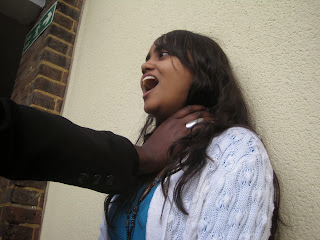In the last lesson, I worked in a group testing out different camera angles to portray a story of a bully and a victim. We did this by using taking the same picture but in different angles and different proximity in order to have different effects on the viewers. Firstly, we learn't about types of shots such as: close-ups, medium shots, long shots and establishing shots (ELS).
One of the shots we tried was a close-up which contains just one characters face. This enables the viewers to understand the actor's emotions and just solely focus on this character thus making the viewer feel sympathy for the charecter. I think we really captured this with our photo as you can see the girls' emotion as she is the main focus.
A long shot is where you give the viewer a more specific idea of the setting. This will show them the landscape, it could be a building which is important in that film. We did manage to get a good long shot showing this although it could have been taken even further away to show distance even more. Furthermore even though this long shot has been taken from a higher angle, it still counts as a long shot because it shows the surrounding however we could have taken it from a greater distance.
This is an example of a close up, where the hand takes sole focus. Close ups are very effective as it makes the viewers focus solely on the hand and in this case it helps to create empathy as it shows a hand on someones shoulder perhaps suggesting that they're friends and she cares about the character.
Here is an example of an extreme close up. Extreme close ups are often used to add effect to to a particular scene, whether its someone talking- to emphasise their words, or in this case someones eyes to perhaps show fear or create suspense and make the viewers question what she's looking at.
This is an example of a low shot. A low angle shot is usually used to suggest that a character is powerful.as they appear bigger, therefore on reflection I can see that this angle wasn't effective and appropriate with this particular shot because we wanted to portray the emotion of fear from the victim of bullying. I now know that if i was to do this again I'd use a high angle shot because they can be used to suggest that a character is isolated, perhaps scared and not in control of his/her surroundings.
For more information on film editing, be sure to check out my other blog.






